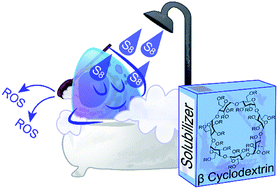Modified cyclodextrins solubilize elemental sulfur in water and enable biological sulfane sulfur delivery†
Abstract
An important form of biological sulfur is sulfane sulfur, or S0, which is found in polysulfide and persulfide compounds as well as in elemental sulfur. Sulfane sulfur, often in the form of S8, functions as a key energy source in the metabolic processes of thermophilic Archaean organisms found in sulfur-rich environments and can be metabolized both aerobically and anaerobically by different archaeons. Despite this importance, S8 has a low solubility in water (∼19 nM), raising questions of how it can be made chemically accessible in complex environments. Motivated by prior crystallographic data showing S8 binding to hydrophobic motifs in filamentous glycoproteins from the sulfur reducing Staphylothermus marinus anaerobe, we demonstrate that simple macrocyclic hydrophobic motifs, such as 2-hydroxypropyl β-cyclodextrin (2HPβ), are sufficient to solubilize S8 at concentrations up to 2.0 ± 0.2 mM in aqueous solution. We demonstrate that the solubilized S8 can be reduced with the common reductant tris(2-carboxyethyl)phosphine (TCEP) and reacts with thiols to generate H2S. The thiol-mediated conversion of 2HPβ/S8 to H2S ranges from 80% to quantitative efficiency for Cys and glutathione (GSH). Moreover, we demonstrate that 2HPβ can catalyze the Cys-mediated reduction of S8 to H2S in water. Adding to the biological relevance of the developed systems, we demonstrate that treatment of Raw 264.7 macrophage cells with the 2HPβ/S8 complex prior to LPS stimulation decreases NO2− levels, which is consistent with known activities of bioavailable H2S and sulfane sulfur. Taken together, these investigations provide a new strategy for delivering H2S and sulfane sulfur in complex systems and more importantly provide new insights into the chemical accessibility and storage of S0 and S8 in biological environments.



 Please wait while we load your content...
Please wait while we load your content...